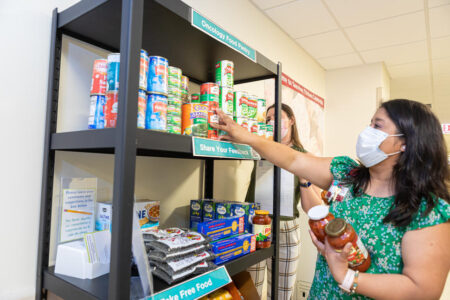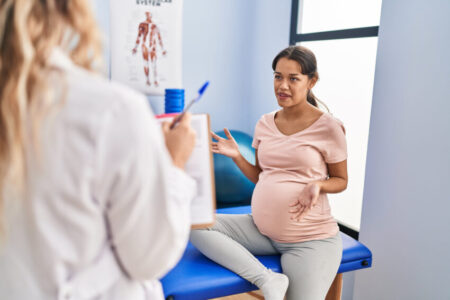
Share On Social!
People need to stay home to prevent the spread of the coronavirus, Covid-19.
However, for the 27% of the U.S. private workforce with no paid sick leave, staying home isn’t an option, particularly for the full prescribed 14-day quarantine.
That’s why a form of paid sick leave and family/childcare leave are part of a new $100 billion relief law, Families First Coronavirus Response Act, which also includes nutrition aid, unemployment health insurance, and free COVID-19 testing.
Trump signed the new law on March 18, 2020. It goes into effect April 2, 2020.
But the new law could leave out up to 19 million workers, roughly 12% of the workforce, including many low-income Latinos, women, and other vulnerable populations, experts say.
Moreover, economists estimate that three million will lose their jobs by summer due to an inevitable coronavirus recession.
“The bill no longer protects workers who need to deal with a longer-term health need of their own or a family members’ related to coronavirus,” Vicki Shabo, senior fellow at New America, told CNN.
Families First Coronavirus Response Act: Paid Sick Leave, Family Leave
The Act aims to address the economic and health impacts of the growing coronavirus crisis.
It provides paid sick leave through two new laws:
- The Emergency Family and Medical Leave Expansion Act amends the Family and Medical Leave Act of 1993(FMLA) to provide two-thirds of an employee’s pay for up to 10 weeks—after 10 days of unpaid leave—with a maximum of $10,000 total.
- The Emergency Paid Sick Leave Act provides full-time employees up to 80 hours (two weeks) of paid sick leave, with a maximum $5,110 total.
According to the National Law Review, to receive the benefit, the employee must be unable to work (or telework) due to a need for leave for one of six reasons:
- The employee is subject to a federal, state or local quarantine or isolation order related to COVID-19;
- The employee has been advised by a health care provider to self-quarantine due to concerns related to COVID-19;
- The employee is experiencing symptoms of COVID-19 and seeking medical diagnosis;
- The employee is caring for an individual who is subject to a federal, state or local quarantine order, or the individual has been advised to self-quarantine due to concerns related to COVID-19;
- The employee is caring for the employee’s son or daughter, if the child’s school or child care facility has been closed or the child’s care provider is unavailable due to COVID-19 precautions; or
- The employee is experiencing any other substantially similar condition specified by Health and Human Services in consultation with the Department of the Treasury and the Department of Labor.
Employers cannot force you to use up your vacation or other sick time to receive this benefit; however, there is a 10-day waiting period before the benefit applies.
However, many employers are excluded from providing paid leave to their employees.
Families First Coronavirus Response Act: Millions of Workers Excluded from Paid Sick Leave, Family Leave Benefits
Economists say somewhere between 6.8 million and 19.6 million workers could be left out of the coronavirus relief law.
Why?
- The bill allows the Secretary of Labor to exclude health care providers and emergency responders.
- The bill allows the Secretary of Labor to exclude employers with 50 or fewer employees.
- The bill excludes employers with 500 or more employees.
Nationwide, roughly 47% of the private sector workforce was employed by an employer with more than 500 employees, according to the U.S. Bureau of Labor Statistics.
Although many workers at large employers get some form of paid sick leave, it often isn’t the prescribed 14 days regarding coronavirus quarantine. In fact, most of those workers have seven or eight paid sick days. About 11% have zero paid sick days.
 Many argue that corporations don’t provide these benefits because they aren’t required to.
Many argue that corporations don’t provide these benefits because they aren’t required to.
This isn’t just the giants─Amazon, Walmart, and McDonalds. Many cities across the US have numerous employers with 500 employees or more.
In Phoenix, 78 employers have more than 500 employees.
In Greater Tulsa, 40 employers have more than 1,000 employees.
In San Antonio, 37,000 residents are employed by just three private employers.
Due to preemption laws in some states, like Texas, cities have been blocked from enacting policies that would have required private employers to provide paid sick leave.
Many claim that to truly protect individual and public health, leaders must also protect financial security, thus strengthen paid leave provisions.
For example, the United Food and Commercial Workers International Union (UFCW), the largest private sector union in the U.S., condemned Congress for passing a relief bill that fails to provide real relief to millions of workers in the grocery, retail and food processing industries.
Why?
The Families First Coronavirus Response Act and its Limited Paid Sick Leave is a Social Justice Issue and Public Health Issue
Lack of paid leave contributes to health inequities among Latinas, Latinos, and low-income families.
“Racial disparities in access to wealth and wealth building are compounded by a lack of access to paid family and medical leave,” according to the National Partnership for Women and Families. “Disparities in access to other economic supports make it more difficult for families of color to absorb the financial shock of a serious family or medical need.”
Food service and childcare workers are especially likely to lack paid sick leave; however, because they interact with the public, these workers have a high probability of spreading infection. A survey of workers found that those without paid sick leave were 1.5 times more likely to go to work when they have a contagious illness than workers with paid sick leave.
Moreover, lack of paid sick leave has significant implications for the health care system.
If paid sick leave is implemented nationally, it would save an estimated $1.1 billion annually, according to the Institute for Women’s Policy Research.
“When workers have paid sick leave, they are less likely to delay medical care when they or family members are sick, which may mean they recover faster and have a less severe illness,” according to Diana Boesch, Sarah Jane Glynn, and Shilpa Phadke with the Center for American Progress.
The UFCW, among many other organizations, is calling on Congress to strengthen worker aid in the relief bill and provide at least two weeks of paid sick leave for all American workers.
Beyond disparities in sick leave, are also disparities in paid family and medical leave.
Women are most effected by the lack of paid family and medical leave.
 Tell health and policy decision-makers in your area we need stronger paid leave provisions to reduce the public’s exposure to coronavirus and protect financial security among Latinos and other vulnerable populations.
Tell health and policy decision-makers in your area we need stronger paid leave provisions to reduce the public’s exposure to coronavirus and protect financial security among Latinos and other vulnerable populations.
“Make sure your business understands the ramifications and how it applies to your business. It’s essential to carry out the new law correctly,” writes Suzanne Lucas of Inc. “When in doubt, call your employment attorney.”
Families First Coronavirus Response Act: Beyond Sick Leave, Paying for Nutrition Assistance Programs
Staying home to slow the spread of coronavirus also introduces food insecurity for many families who rely on school meals and nutrition assistance programs.
Latinos especially suffer food insecurity.
This is why the Families First Coronavirus Response Act is expanding nutrition programs.
The law includes $500 million to the Special Supplemental Nutrition Program for Women Infants and Children (WIC) to provide access to nutritious foods to low-income pregnant women or mothers with young children who lose their jobs or are laid off due to the COVID-19 emergency.
The law includes a general provision that allows the Department of Agriculture to approve state plans to provide emergency SNAP assistance to households with children who would otherwise receive free or reduced-price meals if not for their schools being closed due to the COVID-19 emergency.
Through the Emergency Food Assistance Program (TEFAP), $400 million would go to local food banks for the purchase of nutritious foods and to support the storage and distribution of the foods.
The law also includes $250 million for the Senior Nutrition program to provide meals to low-income seniors who are home-bound, who have disabilities, and who have multiple chronic illnesses, as well as caregivers for seniors who are home-bound.
Additionally, the following nutrition waivers will also protect food security:
- The Maintaining Essential Access to Lunch for Students Act: Provides the Secretary of Agriculture the authority to issue nationwide school meal waivers during the COVID-19 emergency, which will eliminate paperwork for states and help more schools quickly adopt and utilize flexibilities.
- COVID-19 Child Nutrition Response Act: Allows all child and adult care centers to operate as non-congregate (i.e. allows them to take food to go) and waive all meal pattern requirements if there is a disruption to the food supply as a result of the COVID-19 emergency.
- SNAP COVID-19 Response Waivers: Suspends the work and work training requirements for SNAP during this crisis. Allows states to request special waivers from the Secretary to provide temporary, emergency CR-SNAP benefits to existing SNAP households up to the maximum monthly allotment, as well as give the Secretary broad discretion to provide much more flexibility for States in managing SNAP caseloads.
Families First Coronavirus Response Act: Beyond Sick Leave, Free Testing for Covid-19
The new law also seeks to ensure access to free COVID-19 testing.
The bill includes $1 billion for the National Disaster Medical System to reimburse the costs of COVID19 diagnostic testing provided to individuals without health insurance.
It also includes $60 million for the Department of Veterans Affairs to cover the costs of COVID-19 diagnostic testing for veterans receiving care through Medical Services or through Medical Community Care.
Moreover, private health plans will be required to provide coverage—at no cost to the consumer—for COVID-19 diagnostic testing, including the cost of provider, urgent care center, and emergency room visits in order to receive testing.
Families First Coronavirus Response Act: Beyond Sick Leave, Expanding Unemployment Insurance Benefits
Recent guidance from the Department of Labor permits significant flexibility for states to amend their laws to provide unemployment insurance benefits in multiple scenarios related to COVID-19.
For example, according to the Department of Labor, federal law allows states to pay benefits where:
- An employer temporarily ceases operations due to COVID-19, preventing employees from coming to work;
- An individual is quarantined with the expectation of returning to work after the quarantine is over; and
- An individual leaves employment due to a risk of exposure or infection or to care for a family member. In addition, federal law does not require an employee to quit in order to receive benefits due to the impact of COVID-19.
The Families First Coronavirus Response Act provides additional funds to support state’s unemployment insurance programs.
While waiting for the Families First Coronavirus Response Act to go into effect April 2, Congress will be discussing a stimulus package to prevent job losses and boost recovery.
Health and policy decision-makers need more than ever to hear from you to make sure we get a stimulus package that targets low-wage, low-productivity, and low-hours jobs, particularly in service industries and among vulnerable populations.
By The Numbers
23.7
percent
of Latino children are living in poverty



